2007 CHEVROLET CORVETTE tire pressure
[x] Cancel search: tire pressurePage 226 of 488
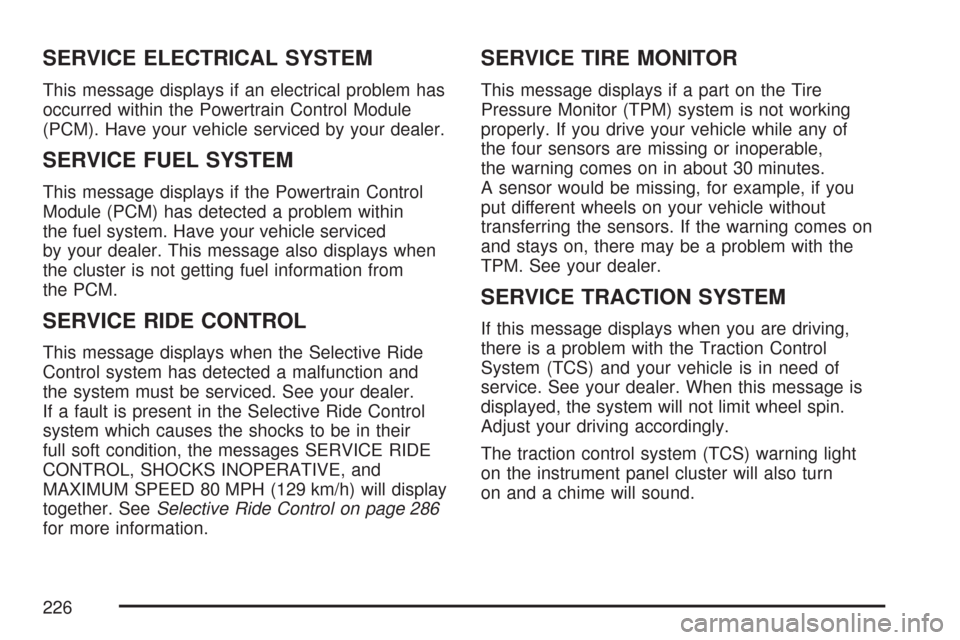
SERVICE ELECTRICAL SYSTEM
This message displays if an electrical problem has
occurred within the Powertrain Control Module
(PCM). Have your vehicle serviced by your dealer.
SERVICE FUEL SYSTEM
This message displays if the Powertrain Control
Module (PCM) has detected a problem within
the fuel system. Have your vehicle serviced
by your dealer. This message also displays when
the cluster is not getting fuel information from
the PCM.
SERVICE RIDE CONTROL
This message displays when the Selective Ride
Control system has detected a malfunction and
the system must be serviced. See your dealer.
If a fault is present in the Selective Ride Control
system which causes the shocks to be in their
full soft condition, the messages SERVICE RIDE
CONTROL, SHOCKS INOPERATIVE, and
MAXIMUM SPEED 80 MPH (129 km/h) will display
together. SeeSelective Ride Control on page 286
for more information.
SERVICE TIRE MONITOR
This message displays if a part on the Tire
Pressure Monitor (TPM) system is not working
properly. If you drive your vehicle while any of
the four sensors are missing or inoperable,
the warning comes on in about 30 minutes.
A sensor would be missing, for example, if you
put different wheels on your vehicle without
transferring the sensors. If the warning comes on
and stays on, there may be a problem with the
TPM. See your dealer.
SERVICE TRACTION SYSTEM
If this message displays when you are driving,
there is a problem with the Traction Control
System (TCS) and your vehicle is in need of
service. See your dealer. When this message is
displayed, the system will not limit wheel spin.
Adjust your driving accordingly.
The traction control system (TCS) warning light
on the instrument panel cluster will also turn
on and a chime will sound.
226
Page 229 of 488
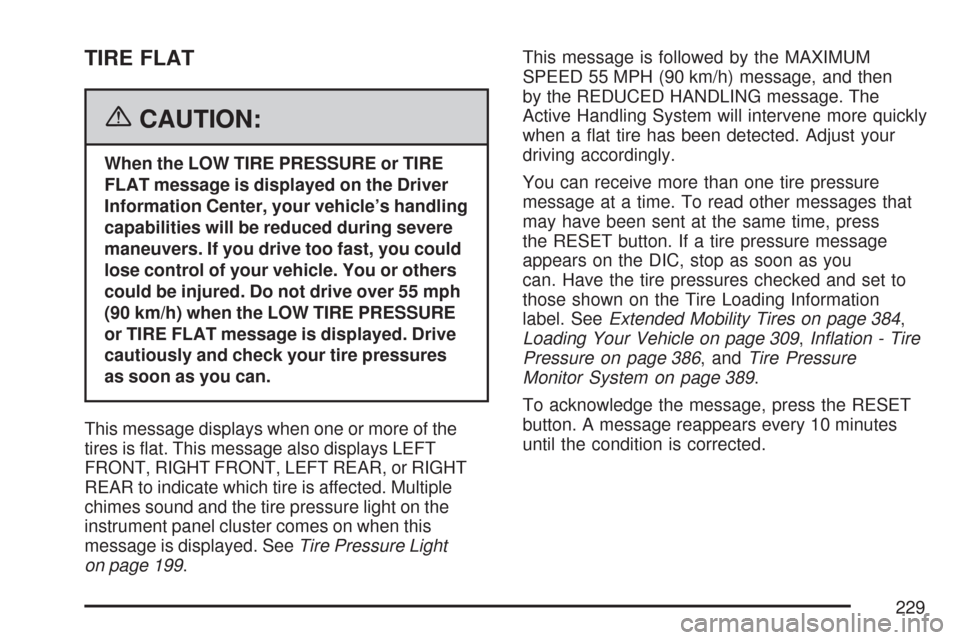
TIRE FLAT
{CAUTION:
When the LOW TIRE PRESSURE or TIRE
FLAT message is displayed on the Driver
Information Center, your vehicle’s handling
capabilities will be reduced during severe
maneuvers. If you drive too fast, you could
lose control of your vehicle. You or others
could be injured. Do not drive over 55 mph
(90 km/h) when the LOW TIRE PRESSURE
or TIRE FLAT message is displayed. Drive
cautiously and check your tire pressures
as soon as you can.
This message displays when one or more of the
tires is �at. This message also displays LEFT
FRONT, RIGHT FRONT, LEFT REAR, or RIGHT
REAR to indicate which tire is affected. Multiple
chimes sound and the tire pressure light on the
instrument panel cluster comes on when this
message is displayed. SeeTire Pressure Light
on page 199.This message is followed by the MAXIMUM
SPEED 55 MPH (90 km/h) message, and then
by the REDUCED HANDLING message. The
Active Handling System will intervene more quickly
when a �at tire has been detected. Adjust your
driving accordingly.
You can receive more than one tire pressure
message at a time. To read other messages that
may have been sent at the same time, press
the RESET button. If a tire pressure message
appears on the DIC, stop as soon as you
can. Have the tire pressures checked and set to
those shown on the Tire Loading Information
label. SeeExtended Mobility Tires on page 384,
Loading Your Vehicle on page 309,In�ation - Tire
Pressure on page 386, andTire Pressure
Monitor System on page 389.
To acknowledge the message, press the RESET
button. A message reappears every 10 minutes
until the condition is corrected.
229
Page 280 of 488
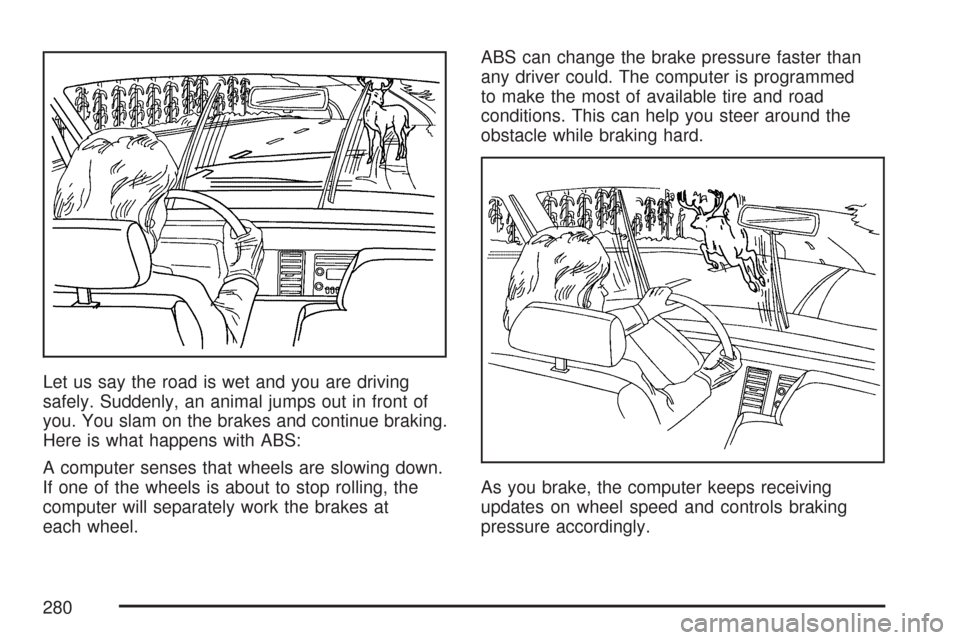
Let us say the road is wet and you are driving
safely. Suddenly, an animal jumps out in front of
you. You slam on the brakes and continue braking.
Here is what happens with ABS:
A computer senses that wheels are slowing down.
If one of the wheels is about to stop rolling, the
computer will separately work the brakes at
each wheel.ABS can change the brake pressure faster than
any driver could. The computer is programmed
to make the most of available tire and road
conditions. This can help you steer around the
obstacle while braking hard.
As you brake, the computer keeps receiving
updates on wheel speed and controls braking
pressure accordingly.
280
Page 284 of 488
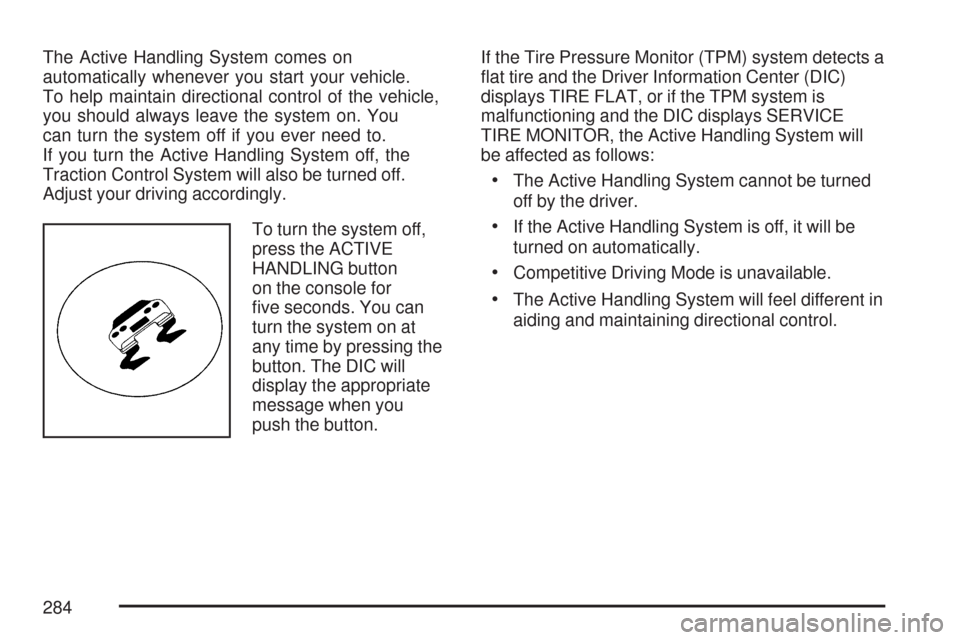
The Active Handling System comes on
automatically whenever you start your vehicle.
To help maintain directional control of the vehicle,
you should always leave the system on. You
can turn the system off if you ever need to.
If you turn the Active Handling System off, the
Traction Control System will also be turned off.
Adjust your driving accordingly.
To turn the system off,
press the ACTIVE
HANDLING button
on the console for
�ve seconds. You can
turn the system on at
any time by pressing the
button. The DIC will
display the appropriate
message when you
push the button.If the Tire Pressure Monitor (TPM) system detects a
�at tire and the Driver Information Center (DIC)
displays TIRE FLAT, or if the TPM system is
malfunctioning and the DIC displays SERVICE
TIRE MONITOR, the Active Handling System will
be affected as follows:
The Active Handling System cannot be turned
off by the driver.
If the Active Handling System is off, it will be
turned on automatically.
Competitive Driving Mode is unavailable.
The Active Handling System will feel different in
aiding and maintaining directional control.
284
Page 296 of 488
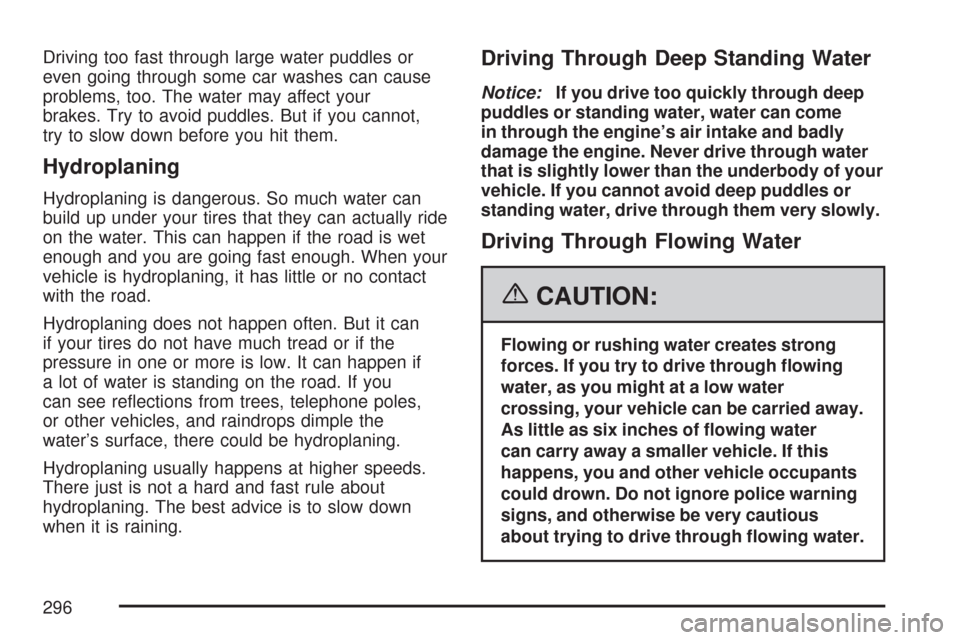
Driving too fast through large water puddles or
even going through some car washes can cause
problems, too. The water may affect your
brakes. Try to avoid puddles. But if you cannot,
try to slow down before you hit them.
Hydroplaning
Hydroplaning is dangerous. So much water can
build up under your tires that they can actually ride
on the water. This can happen if the road is wet
enough and you are going fast enough. When your
vehicle is hydroplaning, it has little or no contact
with the road.
Hydroplaning does not happen often. But it can
if your tires do not have much tread or if the
pressure in one or more is low. It can happen if
a lot of water is standing on the road. If you
can see re�ections from trees, telephone poles,
or other vehicles, and raindrops dimple the
water’s surface, there could be hydroplaning.
Hydroplaning usually happens at higher speeds.
There just is not a hard and fast rule about
hydroplaning. The best advice is to slow down
when it is raining.
Driving Through Deep Standing Water
Notice:If you drive too quickly through deep
puddles or standing water, water can come
in through the engine’s air intake and badly
damage the engine. Never drive through water
that is slightly lower than the underbody of your
vehicle. If you cannot avoid deep puddles or
standing water, drive through them very slowly.
Driving Through Flowing Water
{CAUTION:
Flowing or rushing water creates strong
forces. If you try to drive through �owing
water, as you might at a low water
crossing, your vehicle can be carried away.
As little as six inches of �owing water
can carry away a smaller vehicle. If this
happens, you and other vehicle occupants
could drown. Do not ignore police warning
signs, and otherwise be very cautious
about trying to drive through �owing water.
296
Page 300 of 488
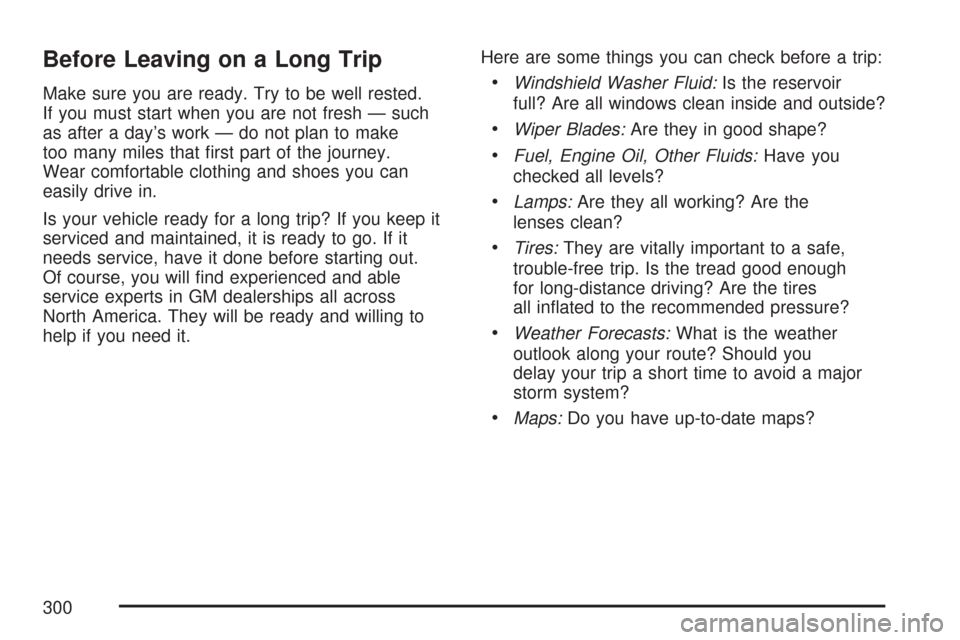
Before Leaving on a Long Trip
Make sure you are ready. Try to be well rested.
If you must start when you are not fresh — such
as after a day’s work — do not plan to make
too many miles that �rst part of the journey.
Wear comfortable clothing and shoes you can
easily drive in.
Is your vehicle ready for a long trip? If you keep it
serviced and maintained, it is ready to go. If it
needs service, have it done before starting out.
Of course, you will �nd experienced and able
service experts in GM dealerships all across
North America. They will be ready and willing to
help if you need it.Here are some things you can check before a trip:Windshield Washer Fluid:Is the reservoir
full? Are all windows clean inside and outside?
Wiper Blades:Are they in good shape?
Fuel, Engine Oil, Other Fluids:Have you
checked all levels?
Lamps:Are they all working? Are the
lenses clean?
Tires:They are vitally important to a safe,
trouble-free trip. Is the tread good enough
for long-distance driving? Are the tires
all in�ated to the recommended pressure?
Weather Forecasts:What is the weather
outlook along your route? Should you
delay your trip a short time to avoid a major
storm system?
Maps:Do you have up-to-date maps?
300
Page 310 of 488

Tire and Loading Information Label
A vehicle speci�c Tire and Loading Information
label is attached to the center pillar (B-pillar) of your
vehicle. With the driver’s door open, you will �nd the
label attached below the door latch.This label shows the number of occupant seating
positions (A), and the maximum vehicle capacity
weight (B) in kilograms and pounds.
The Tire and Loading Information label also shows
the size of the original equipment tires (C) and
the recommended cold tire in�ation pressures (D).
For more information on tires and in�ation see
Tires on page 378andIn�ation - Tire Pressure
on page 386.
There is also important loading information on the
vehicle Certi�cation label. It tells you the Gross
Vehicle Weight Rating (GVWR) and the Gross Axle
Weight Rating (GAWR) for the front and rear axle.
See “Certi�cation Label” later in this section.
Label Example
310
Page 317 of 488

Service........................................................ 319
Accessories and Modi�cations................... 319
California Proposition 65 Warning.............. 320
Doing Your Own Service Work.................. 320
Adding Equipment to the Outside
of Your Vehicle...................................... 321
Fuel............................................................. 321
Gasoline Octane........................................ 321
Gasoline Speci�cations.............................. 322
California Fuel........................................... 322
Additives................................................... 323
Fuels in Foreign Countries........................ 324
Filling the Tank......................................... 324
Filling a Portable Fuel Container............... 327
Checking Things Under the Hood.............. 328
Hood Release........................................... 329
Engine Compartment Overview.................. 330
Engine Oil................................................. 333
Engine Oil Life System.............................. 340
Engine Air Cleaner/Filter............................ 342
Automatic Transmission Fluid.................... 345
Manual Transmission Fluid........................ 345
Hydraulic Clutch........................................ 346
Engine Coolant.......................................... 347
Coolant Surge Tank Pressure Cap............ 350Engine Overheating................................... 350
Overheated Engine Protection
Operating Mode..................................... 352
Cooling System......................................... 353
Power Steering Fluid................................. 358
Windshield Washer Fluid........................... 360
Brakes...................................................... 361
Battery...................................................... 364
Jump Starting............................................ 365
Rear Axle.................................................... 370
Bulb Replacement....................................... 371
High Intensity Discharge (HID) Lighting..... 371
Halogen Bulbs........................................... 372
Headlamps, Front Turn Signal, and
Parking Lamps....................................... 372
Taillamps, Turn Signal, and Stoplamps...... 374
Replacement Bulbs................................... 374
Windshield Replacement............................ 375
Windshield Wiper Blade Replacement....... 375
Tires............................................................ 378
Winter Tires.............................................. 379
Tire Sidewall Labeling............................... 380
Tire Terminology and De�nitions............... 382
Extended Mobility Tires............................. 384
In�ation - Tire Pressure............................. 386
Section 5 Service and Appearance Care
317